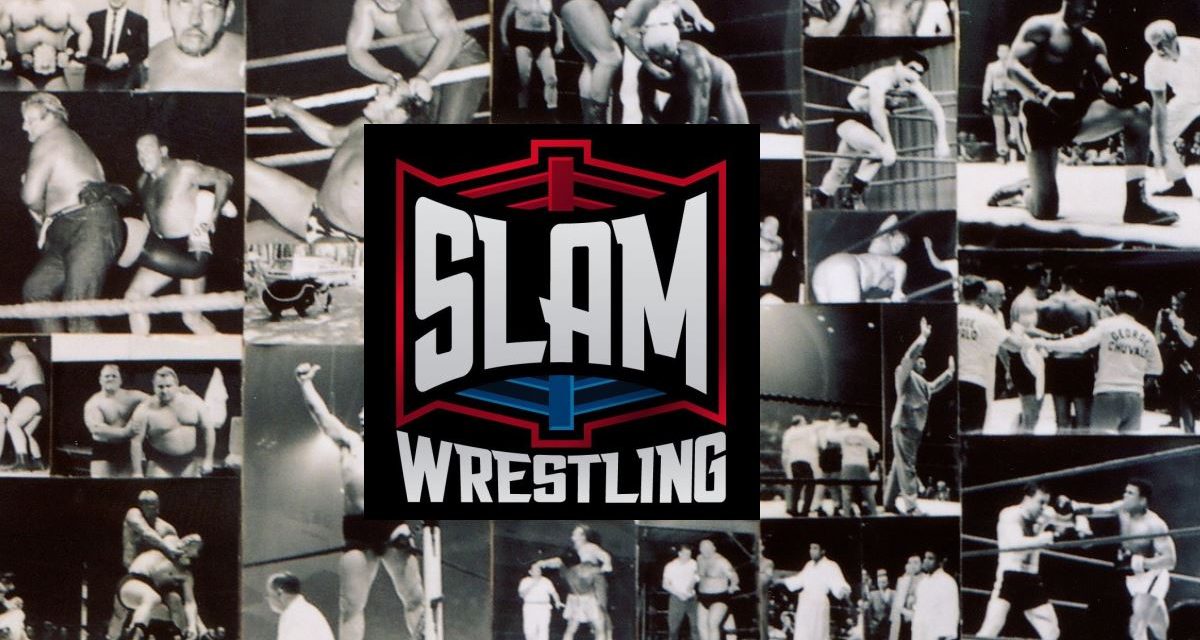Among wrestlers, Gerald “Jerry” Brisco is something of a renaissance man: he has truly done it all.
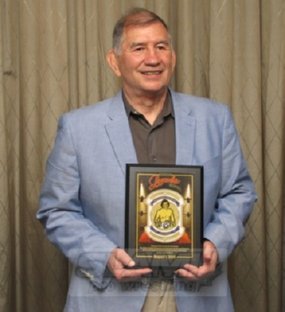
Gerry Brisco and his Hall of Heroes plaque at the Mid-Atlantic Wrestling Legends Fan Fest in Charlotte, NC, on Friday, August 1, 2014. Photo by Steve Johnson.
From amateur success to tag-team glory with his brother Jack to three decades as a backstage agent and talent scout, Brisco has lived and breathed wrestling for practically his whole life.
So it should be no surprise to anyone who has followed his career that Brisco will receive the Lou Thesz Lifetime Achievement Award at the Cauliflower Alley Reunion in Las Vegas, April 12-15. SLAM! Wrestling recently caught up with Brisco for an in-depth chat about his life, career, and perspectives on the future of wrestling.
In part two of our interview, Brisco delves into WrestleMania, innovators, and giving back to the business.
SLAM! Wrestling: How did you enjoy the business part of things — such as holding controlling interest in Georgia Championship Wrestling — compared to being in the ring?
Jerry Brisco: I enjoyed the in-ring aspect of the business more than being an owner, because you had so much responsibility and it was real stressful because you can’t make everybody happy. And I think that’s why I got along with Vince McMahon so well: because I knew, being an owner, what he had to go through trying to make everybody happy. And you can’t make everybody happy, so it’s real stressful. I felt real fortunate to be in that position, though, as not many guys ever had that opportunity. But I saved my money at that time and so I had a good run right out of that shoot, so I was able to invest. So we kept a small percentage and then kept it for a while and then we kept it growing until we had to ride (Vince McMahon) out with the percentage to make some money. It was a great opportunity that not a lot of guys got back in that day.
SLAM! Wrestling: In the late ’70s, you and Jack discovered Terry Bollea, the future Hulk Hogan…
Jerry Brisco: I’m involved real heavy in the Dan Gable Museum Hall of Fame in Waterloo, Iowa. There’s one guy, I’m not going to give his name, but he started blasting Hulk Hogan, and I said, “Hey this guy has drawn more money in a year than anybody you can name drew in a lifetime!” So why are you on him? What makes a good worker? Is it the amount of tickets he sells or the quality of the matches? Or is a combination of both?” And I think Terry is underrated in his wrestling ability. He was trained by Hiro Matsuda.
Anyone who has seen Hogan versus Backlund or Hogan versus Antonio Inoki in Japan knows those matches were classics. So the bottom line is, a lot of old-timers get bitter and it kind of upsets me because I’m with the product now, and I respect it. I think these guys are better athletes nowadays than we were, but overall we had our share of great athletes. But nowadays, I think anybody who gets in that ring is a tremendous athlete and knows what to do and they’re well trained, and these kids have respect for the business. And they have respect for the past, so I’ve got no problem with it. I just enjoy the heck out of it.
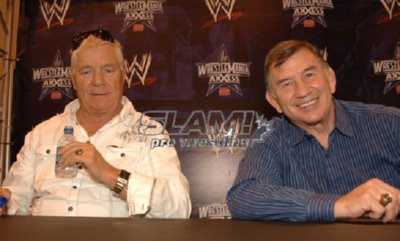
Pat Patterson and Jerry Brisco at a WWE Fan Axxess event. Photo by Mike Mastrandrea.
I’m talking about guys like Damien Sandow. Damien is a young man that I’m really proud of. He’s put himself together and he came up with that gimmick himself, and [then] went down to Puerto Rico and worked on it. And when he came back he was ready, and he came up and the guy got over big time. He’s very creative in the ring and what he’s doing now with The Miz to me is hilarious. He’s so good, then when he gets in the ring he really works and shows his abilities.
Another guy is Dolph Ziggler. I think Dolph Ziggler would be a star in any time period in wrestling no matter where he would have been back in those days. He’s a true wrestler and a real worker, and very studious in his studies of the business. Whatever era you put him in, the ’50s, ’60s, ’70s, ’80s, ’90s, whatever, Dolph Ziggler would be a star.
SLAM! Wrestling: Tell us about the Cauliflower Alley Club reunion and the road stories you all share with your peers.
Jerry Brisco: Like every other sport and every other convention, the older you get the better you were (laughs). So we exaggerate our stories and we tell lies to each other. We know we’re lying to each other but it’s all in fun. And it’s great seein’ guys like Dick Beyer and Nick Bockwinkel — and I pray to God that Nick’s with us in April, and able to attend. I have so much respect for his abilities.
I really enjoy seeing the old-timers and sharing some old road stories, and we had some great road stories. Some are not suitable for a mixed audience, but they’re great stories and it’s great to see these guys. We also talk about our families. And you get to see them in a different environment than what you’re used to, rather than a locker room or in the hallway of an arena. It’s about seeing them in a really fun atmosphere, and anybody who’s never attended should come experience it.
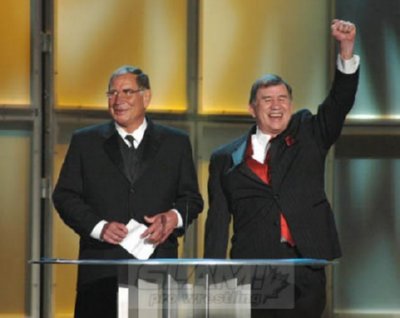
Jack and Jerry Brisco at their WWE Hall of Fame induction. Photo by Mike Mastrandrea.
And this is the 50th one coming up. And that’s what really makes this a special award for me: because it’s such a special event. Like I said, I’m just really honoured to be awarded the Lou Thesz Award and I’m looking forward to it. I get nervous thinking about it. You know last year I had the pleasure of introducing Michael Hayes for the award, and Michael called me the day before and I was actually a fill in for him. Originally, there was a comedian who was going to introduce Michael, but he had a close friend pass away at the same time and had to attend her funeral. So Michael called and said, “I know it’s late but would you introduce me, it would be an honour for me,” and I said sure.
So I said, “Michael, will you send me some info, I mean I lived most of your career?” So he sent me this big long list of matches he had over the years and I said, “What the hell am I going to do with this?” So I kind of just threw it away and I went and made of joke of it when I introduced him. I came up with a phone book and I said, “Michael sent me an email with a list of his matches,” so I held up the phone book with a black cover on it, a big thick phone book and I held it on my shoulder and said, “I’m just going to tell my story and what I know about this guy.” So that was a big honour, and I was nervous as well because he didn’t give me much time to prepare. So this year I’ve been given about four months so I better be better than I was last year.
SLAM! Wrestling: Michael Hayes was excited about receiving the 2014 Lou Thesz Award, and SLAM! Wrestling spoke to him just before last year’s reunion…
Jerry Brisco: Michael was an innovator. That was the message I wanted to convey when I introduced him. When you get into this business you don’t think, well now I want to win the Lou Thesz Award or I want to be in the Hall of Fame. You just think, man I want to make it through the next year. But what sets you apart, is if you can go in the ring and be an innovator. Lou Thesz was an innovator because of his style of wrestling. Jack and I were innovators for our style of wrestling and our background. Michael Hayes, coming in was an innovator with the Freebirds and taking the business to the next level, because when the Freebirds came along society changed too. People were becoming hipper, so you had to be with the times and Michael grabbed that by the horns and wow, look what they did. So it was a real honour to introduce Michael at the CAC last year.
SLAM! Wrestling: Who will be introducing you at the Cauliflower Alley Club when you receive your award?
Jerry Brisco: Well, I’ve already asked him and I’m going to let that be a surprise. But I can tell you he’s a fellow Oklahoman and a very good friend of mine.
SLAM! Wrestling: These days, fans see a lot of you in the documentaries and shows on the WWE Network, offering great insight into the history of the business.
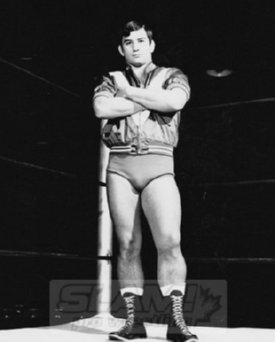
A young Jerry Brisco.
Jerry Brisco: Well, thank you and I’m just blessed that they use me a lot on those things. I really appreciate it and I get a thrill out of. Two weeks ago I had to go to the Performance Centre and do some Network work, and it was scheduled for two hours and we ended up working for over five hours.
I’m blessed with having the honour of working with people like Terry [Taylor] and all the other great athletes that I’ve come across behind the scenes. And I still feel I’m blessed everyday to be a part of this thing, 30 years now with the WWE.
I think very few of us now, me and Pat Patterson and Howard Finkel last year at WrestleMania 30 we were trying to figure out who, besides the McMahons, had been to all 30 of them, worked 30 WrestleManias. So it was Patterson, myself and Finkel. And there’s one other lady who didn’t make it last year but she worked in the studio at WWE. But very few people can say that and I just feel blessed that I’ve been there that long.
SLAM! Wrestling: Where do you watch WrestleMania?
Jerry Brisco: We watch in a box in the stadium. They have a box for us. They cater, they’ve got whatever they need there, and it’s very comfortable. It’s been five years since I had my health issues and the doctor doesn’t want me to go back to that kind of stress, working backstage. So I don’t do that part of it anymore, so I can go and really enjoy the show now.
Because for the first 25 of them, I was working and it was a job. That’s how you got to look at it and accept it. You’re not there to enjoy something; you’re there to do a job, that’s what you’re paid to do. So for 25 years I’ve been a fan and I’m still a fan. I love it. I love being a fan. I respect everybody out there who pays a dollar, or the $9.99 to get the Network (laughs). I respect ’em and thank ’em, and I’m a fan just like everybody else.
And when I see a great match it excites me. Like last year at WrestleMania, when Undertaker got beat, I didn’t know that was going to happen. It was a shock to me just like it was for 90,000 people, or the three million people watching. It was a shock to me too. And I probably felt the same way a lot of people did. I didn’t want to see The Streak end. That was something I never wanted to see end, like how everything else ends. I was a fan and I was upset, even though Brock Lesnar is one of my guys. He’s one of my guys that I brought in the business, but it was still a shock to me. Of course we all have our opinions about it, but it wasn’t my call. And I’m glad it wasn’t my stress to make that call so I could just enjoy it as a fan. And then afterwards at the post-party, I was talking with people and we agreed, if the Undertaker’s streak is going to end, who else is better to end it? If you’re a monster then to got to get beat by a monster, and Brock’s a bonafide monster.
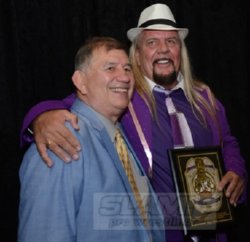
Jerry Brisco and Michael Hayes at the 2014 Cauliflower Alley Club reunion. Photo by Brad McFarlin.
SLAM! Wrestling: Has Brock Lesnar always been a monster?
Jerry Brisco: Oh yeah, and each time I see him now he’s a bigger monster than he ever was. I had the pleasure of seeing him wrestle in college. Imagine as a fan seeing him walk out, but then imagine standing on that other side of the mat and grasping what you’re up against, seeing him walk out and trying to go seven minutes with him. Imagine what kind of feeling that is? He’s the biggest, baddest guy on the face of the earth.
SLAM! Wrestling: Would you say Brock Lesnar is an attraction similar to Andre the Giant?
Jerry Brisco: Yes, that’s exactly what he has become, an attraction like Andre or Haystacks Calhoun. Seeing those guys was special, and I think WWE has done a great job with keeping that mystique about Brock. What’s inside this guy? And I love the guy to death. Paul Heyman has done just a tremendous job being the spokesman for Brock. It was absolutely brilliant to put Paul and Brock together. I think [Paul’s] really enhanced the character also, and made Brock more of a mystery and a “must see” guy.
SLAM! Wrestling: Some of your classic matches can still be seen on various WWE-produced DVDs and programs like The Film Room with Gordon Solie. What would be the oldest footage you’ve seen from your career?
Jerry Brisco: Well, the oldest footage I’ve got I think is from the ’70s with Jack and I against the Funks in Florida. I’ve got to dig them all out one of these days and put them together. I’ve got them all scattered. And I’ve got some of the arena footage that was shot from back then. Are you familiar with the Florida Championship Wrestling TV shows? Well, the angle you remember was a one camera shot from a crow’s nest in the armory, and back in those days you could smoke in the arenas, so you’ve got the smoke-filled arena with about 3,000 people packed, smokin’. So the smoke was thick, and in the summertime it might be 95 degrees outside, and about 110 under those lights in the arena. And me being a non-smoker, I’d walk out to that ring knowing you got to go an hour with the Funks, so those are the kinds of things I remember when I see that old footage.
But the camera shot from the crow’s nest, it’s really antique looking and makes me feel older than I am (laughs). And I’m old. But I enjoy watching that stuff, like I said, I’m just such a huge fan. I watch every form of wrestling I can. I don’t care what brand it is. I go to high school tournaments here in Tampa, I go to college tournaments, I go watch independent shows around Tampa. I just love the business and I love the product. And I hope I never lose that feeling. I don’t think I will. I’ve got the same passion for it now that I did the very first night I jumped in that ring in Joplin, Missouri.
SLAM! Wrestling: What did you learn from Florida promoter Eddie Graham?
Jerry Brisco: Eddie was community minded. Most of the old promoters were because you had to deal with the community to make a living there. So Eddie taught all his wrestlers, “If you’re going to be here you’re going to be a part of this community. You’re going to contribute to the community.”
In 1968, when I first came to Tampa right out of Oklahoma State, he had Jack and I probably go to just about every high school in the state putting on clinics. And it did us good. I have coaches still come up to me today and tell me Jack and I were the reason they got into amateur wrestling: because we came and did a clinic at their school and they watched us on TV. It’s thrilling and it really makes you feel good that you had that kind of effect on people.
And Jack was so respected in Florida. When he died, it was a sad day, of course, but there at his funeral we had lawyers, judges, doctors, and so on. It was the who’s who of the Tampa community paying their respects to my brother, and they were so good to us. And the respect that he had is immeasurable. I go places now and it’s so rewarding, people come up and say, “Hey I remember you and your brother Jack.” We invested in the community, it paid off, and that was something instilled in us by Eddie Graham. He taught us to give back.
SLAM! Wrestling: You’re still giving back to the business…
Jerry Brisco: And it still feels really good. Y’know, maybe that’s what this business is all about, it really is. Passing it on. And if you can’t do that then you’re selfish. What have I got to do besides that? I have had a fortunate career and am truly blessed, and I was able to make something of myself and I want to pass that along. I want other people to be talking to writers like you down the road, about the great careers they’ve had and their love for this business.
I just love going over there and seeing those kids at NXT, tearing down the house. It makes me feel younger, it makes me feel appreciated, and it makes me feel the passion again. And that’s important. I’ve tried to surround myself with positive people my whole life.
I hope I’m able to contribute for a long time. And hopefully the legacy lives on.
RELATED LINKS
